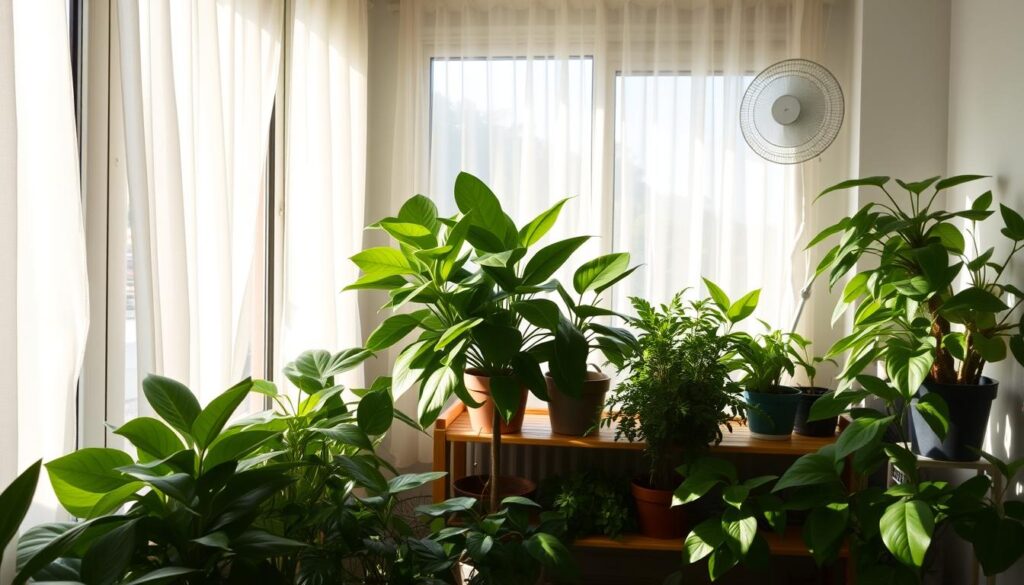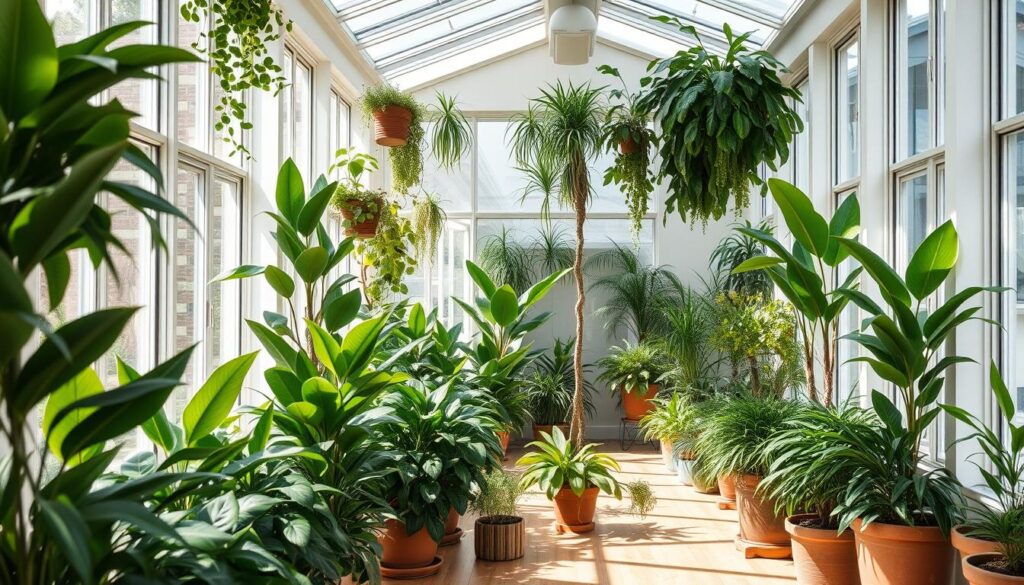Did you know over 70% of indoor gardeners face challenges with air quality for their plants? Good indoor plant ventilation is key for keeping plants alive and helping them grow well. It lets them breathe better, absorb nutrients, and thrive indoors.
In this guide, we’ll share effective tips for better indoor plant ventilation. These tips will help improve air quality and ensure your plants breathe well indoors.
Key Takeaways
- Indoor plant ventilation is vital for plant health.
- Effective air circulation improves nutrient absorption.
- Optimizing indoor plant breathing leads to vibrant growth.
- Watch for signs that your plants may need more ventilation.
- Implementing ventilation tips can enhance overall plant vitality.
Understanding Indoor Plant Ventilation
Indoor plant ventilation is key to keeping your plants healthy. It moves air around your indoor garden like the outdoors. This air movement helps plants grow and stay well.
What Is Indoor Plant Ventilation?
Indoor plant ventilation controls air flow in indoor gardens. It makes sure plants get enough fresh air. This air exchange is vital for plant growth and health.
It lets plants absorb oxygen and release carbon dioxide. This supports photosynthesis and respiration. Good air movement keeps plants healthy and helps them grow.
Why Is It Important for Plant Health?
Good indoor plant ventilation is essential for plant health. It improves gas exchange, which is crucial for growth. This prevents mold, mildew, and pests that harm plants.
Proper ventilation reduces disease risks. It helps plants thrive indoors. Knowing the importance of ventilation ensures your plants flourish.
Signs Your Indoor Plants Need Better Ventilation
It’s important to know when your plants need better air. Some signs show if they’re not getting enough air. Spotting these early can help keep your plants healthy and happy.
Wilting or Yellowing Leaves
Wilting or yellow leaves mean your plants are stressed. This stress often comes from too much humidity or bad air flow. Fixing the air can help your plants stay healthy.
Mold or Mildew Growth
Mold or mildew on leaves or soil is a bad sign. It happens when air is too still and damp. To stop this, make sure your plants have good air flow.
Stunted Growth Patterns
Stunted growth means your plants aren’t getting enough air. Without good air flow, they can’t grow well. Watching for this can help you fix their environment.
Benefits of Adequate Ventilation for Indoor Plants
Knowing the benefits of indoor plant ventilation is key for gardeners. Good airflow helps plants stay healthy and makes the space better for everyone. Here are some main points showing why ventilation is important.
Improved Air Quality
Good ventilation greatly improves indoor plant air quality. It swaps out old air for new, cutting down on harmful particles. This clean air makes the space safer for plants and people.
Increased Growth Rates
Plants need carbon dioxide to grow well. Ventilation helps plants get this, speeding up their growth. With the right air, plants grow stronger and faster.
Pest Control
Ventilation also helps control pests. It keeps humidity levels right, stopping pests that like damp places. With enough air flow, plants are less likely to get infested, staying healthy.
Ideal Indoor Plant Ventilation Conditions
Creating the perfect environment for indoor plants is key. Understanding temperature, humidity, airflow, and light is crucial. These factors help plants breathe better and thrive.
Temperature and Humidity Levels
Keeping the right temperature and humidity is vital. Most plants prefer daytime temperatures between 65°F and 75°F (18°C to 24°C). At night, it should be a bit cooler. Humidity levels of 40% to 60% are ideal for plant health.
To maintain these levels, use humidifiers or pebble trays with water. This helps plants breathe better.
Airflow Patterns
Airflow is important for ventilation. Stagnant air can cause moisture buildup and fungal diseases. Place plants near air sources like vents or windows.
Organize your plants to ensure each gets enough air. This prevents overcrowding and promotes healthy growth.
Light Exposure
Light is essential for photosynthesis and evaporation. Plants need indirect sunlight for several hours a day. This helps with ventilation and growth.
Rotate your pots regularly. This exposes all sides to light, helping plants grow strong and healthy.
| Condition | Ideal Range | Impact on Health |
|---|---|---|
| Temperature | 65°F – 75°F (18°C – 24°C) | Prevents stress, enhances growth |
| Humidity | 40% – 60% | Promotes healthy respiration |
| Airflow | Consistent, gentle air movement | Reduces mold risk, improves breathing |
| Light | Indirect for 6-8 hours | Supports photosynthesis, encourages growth |
How to Achieve Optimal Indoor Plant Ventilation
To create the best environment for indoor plants, you need to take a few steps. These steps help improve air flow. This ensures your plants grow well and stay healthy.
Positioning Your Plants
Placing your plants wisely is key to good air flow. Make sure they have enough space so air can move around them. If plants are too close, they can trap moisture and heat, causing problems.
Try to arrange your plants so there’s room for air to pass through. This way, you avoid overcrowding and ensure air can move freely.
Utilizing Fans Effectively
Fans are great for improving air flow around your plants. Oscillating or ceiling fans can help keep air moving. This prevents air from getting stuck.
When using fans, keep the speed low. This mimics a natural breeze and helps your plants grow well.
Opening Windows and Doors
Using natural ventilation is a big help. Open windows and doors when it’s not too hot or cold outside. This lets in fresh air and improves air circulation.
Doing this regularly makes your plants’ environment healthier. It’s a simple yet effective way to keep your plants happy.
Natural Ventilation Techniques
To improve indoor plant ventilation, we need to focus on airflow. Cross-ventilation is key for plant health. It uses opposing openings to let air flow, making the air better for plants.
Cross-Ventilation Strategies
Think about your space’s layout for cross-ventilation. Place windows and doors on opposite sides for strong airflow. Opening several openings at once helps air move through, making your home more comfortable and healthy for plants.
Using Air Currents
Using air currents can greatly improve your plants’ environment. Place plants near windows for sunlight and breeze. This simple step helps create a better growing space. It’s all about making the most of natural ventilation.

| Technique | Description | Benefits |
|---|---|---|
| Window Placement | Position plants near windows for optimal airflow. | Enhances air circulation naturally and provides sunlight. |
| Opposing Openings | Open windows and doors on opposite walls. | Enables strong cross-ventilation and efficient air exchange. |
| Strategic Arrangement | Arrange plants to maximize airflow around them. | Reduces humidity buildup, preventing mold growth. |
Mechanical Ventilation Options
Understanding mechanical ventilation for indoor plants is key for their health. This section looks at different mechanical solutions. These include exhaust fans, air purifiers, and duct systems. They all help improve air quality and circulation in closed spaces.
Exhaust Fans
Exhaust fans are vital in indoor gardening. They remove stale air filled with moisture and harmful gases. By placing these fans in the right spots, growers can bring in fresh air. This prevents heat and humidity buildup that can harm plants.
Air Purifiers
Air purifiers greatly improve air quality for indoor plants. They filter out pollutants, allergens, and dust. This makes the environment cleaner for plants. Many air purifiers also help circulate air, which plants need to grow well indoors.
Duct Systems
Duct systems improve air exchange in indoor spaces. They allow for controlled airflow and temperature. These systems work well in larger grow areas, ensuring all areas get enough ventilation. A well-designed duct system can greatly improve air movement and plant health.
Seasonal Considerations for Ventilation
Seasonal changes impact indoor plant health a lot. It’s key to manage air circulation during these times. Dry winter air and summer heat require special ventilation tips. Knowing how to improve air in winter and find summer solutions is vital for a healthy indoor garden.
Winter Challenges
Winter brings its own set of challenges, like closed windows and low humidity. These can dry out your plants. Here are some strategies to help:
- Increase humidity by placing trays of water near your plants or using a humidifier.
- Rotate plants regularly to ensure all sides receive appropriate airflow.
- Open windows on warm days for a brief period to introduce fresh air.
Summer Solutions
Summer heat can be a problem for plants. Here are some ways to keep them cool:
- Install fans strategically to promote better air circulation around your plants.
- Shade vulnerable plants with sheer curtains to protect them from excessive sunlight.
- Keep windows open early in the morning or later in the evening to encourage cooler temperatures indoors.
| Season | Challenges | Solutions |
|---|---|---|
| Winter | Dry air, closed windows | Increase humidity, rotate plants |
| Summer | Overheating | Install fans, provide shade |
Choosing the Right Indoor Plants for Your Space
Choosing the right indoor plants is key to a healthy garden. Knowing what plants need helps you pick the best ones for your space. We’ll look at plants that do well with little air and those that need more.
Low-Ventilation Plants
For spots with less air, pick plants that don’t need much. Here are some good ones:
- Pothos: An easy-care vine that tolerates low light and stagnant air.
- Snake Plant: Adaptable to various lighting conditions and excellent at filtering indoor air.
- Peace Lily: Blooms beautifully while handling lower airflow situations gracefully.
High-Ventilation Plants
For areas with plenty of air, choose plants that love it. Some great options are:
- Spider Plant: Thrives in well-ventilated areas and helps purify the air.
- Ferns: Love humidity and require good air circulation to flourish.
- Chinese Evergreen: Adaptable and can thrive in higher airflow environments.
When picking plants, think about what they need. This way, you’ll make a space that’s good for both beauty and growth.

| Plant Type | Best Conditions | Benefits |
|---|---|---|
| Low-Ventilation Plants | Less airflow, low light | Easy care, air purification |
| High-Ventilation Plants | Good airflow, moderate light | Air purification, aesthetic appeal |
Common Ventilation Mistakes to Avoid
Knowing how important good indoor plant ventilation is can stop many problems. Mistakes in plant ventilation can slow down plant growth and lead to mold. It’s key to not overcrowd indoor plants and keep air moving well. Here are some big mistakes to avoid.
Overcrowding Plants
One big ventilation error in gardening is putting too many plants together. When plants are too close, air can’t move freely. This traps moisture, making it easy for mold and mildew to grow. To help plants grow well and breathe, give each one enough room. Check how plants are arranged often and adjust to prevent overcrowding.
Ignoring Seasonal Changes
Another mistake is not paying attention to the seasons. Each season brings different weather that affects plants. For example, winter might mean less sunlight, so plants need to be moved. Summer can be too hot, so plants need better air flow. By adjusting to these changes, you can keep plants healthy and well-ventilated.
Monitoring and Adjusting Ventilation
Keeping the air right for plants is an ongoing task. Regular checks on plant health help spot air issues early. By watching for changes in how plants look and grow, you can fix air problems fast. Using tech helps keep your plants looking great and healthy.
Regular Plant Health Checks
Doing regular health checks on plants is key. These checks help you:
- Catch wilting or color changes early.
- See if plants are growing right or not.
- Find pests or diseases.
Set a schedule for these checks. It could be every week or two, based on what your plants need.
Using Humidity and Temperature Sensors
Humidity sensors for plants give you exact moisture levels. Temperature sensors check if it’s right for growth. By watching these, you can:
- Change air flow if it’s too humid.
- Keep the temperature just right for growth.
- Use data to pick the best spot for plants and improve air flow.
These sensors help you keep an eye on your plants and adjust as needed. This way, you create the perfect spot for them to thrive.
| Sensor Type | Purpose | Benefits |
|---|---|---|
| Humidity Sensors | Monitor moisture levels | Prevent overwatering or mold growth |
| Temperature Sensors | Watch ambient temperatures | Maintain ideal conditions for plant growth |
| Combined Sensors | Track both humidity and temperature | Provide comprehensive environmental control |
Conclusion: Ensure Your Indoor Plants Thrive with Proper Ventilation
Indoor plant ventilation is key to your plants’ health. We’ve looked at many tips for better air flow, from spotting when plants need more air to setting up the best indoor spots. Good air flow boosts growth, fights pests, and makes the air cleaner.
To keep your plants healthy, use the tips we shared. Place plants right, use fans, and catch natural breezes. Always check and tweak the air flow to keep your plants looking great.
Start learning more about indoor gardening and try new air flow methods. This will help you make a space where your plants can grow well. With the right care, your plants will add beauty to your home.
FAQ
What is indoor plant ventilation?
Indoor plant ventilation is about moving air around plants indoors. It’s key for their health. It makes the air feel like outside, helping plants breathe and grow.
Why is ventilation important for plant health?
Good ventilation keeps air moving, stopping moisture buildup. This helps prevent diseases and pests. It also helps plants absorb nutrients and grow strong.
What are the signs that my indoor plants need better ventilation?
Signs include wilting leaves, mold, and slow growth. These show plants might not be getting enough air.
What are some indoor plant ventilation tips?
Place plants to let air flow. Use fans and keep plants apart. Check humidity and adjust your home to improve air.
How can I improve the air quality around my indoor plants?
Improve air quality by ensuring good airflow. Use air purifiers and clean plants to reduce dust.
What mechanical ventilation options are available for indoor plants?
Options include exhaust fans, air purifiers, and duct systems. They help move and clean the air.
How does seasonal change affect indoor plant ventilation?
Seasons change air and plant needs. Winter air is drier, and summer can be hot. Adjust ventilation with the seasons to keep plants healthy.
Are there specific indoor plants that require more ventilation?
Yes, some plants need more air. Spider plants and ferns do well with good airflow. Pothos can handle less air.
What common mistakes should I avoid regarding indoor plant ventilation?
Don’t overcrowd plants, as it blocks air and causes mold. Also, changing seasons require adjusting ventilation to keep plants healthy.
How can I monitor and adjust ventilation for my indoor plants?
Check plants regularly and watch for changes. Use sensors for humidity and temperature to guide adjustments for better air.


